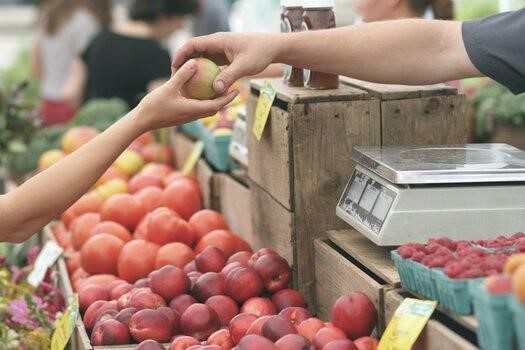By: Megan Ng, Undergraduate Student of Food Science and Human Nutrition at the University of Illinois at Urbana Champaign
Farmer’s market season is upon us, and a variety of summer fruits and vegetables will be hitting the shelves. The hot topic with this influx of seasonal produce is whether to buy organic or conventional.
Organic vs. Conventional
Organic farming methods differ from conventional farming in several ways: (It’s Easy Being Green: Organic vs. Conventional Foods—The Gloves Come Off, 2008), (Vigar, 2019)
- Conventional farming uses chemical fertilizers to promote plant growth. Organic farming uses manure and compost to fertilize the soil.
- Conventional farming sprays pesticides to get rid of pests. Organic farmers use natural pesticides or rely on insects, birds, and traps. *
- Conventional farming uses chemical herbicides to manage weeds. Organic farming rotates crops, hand weeds, or mulches.
- Conventional farmers give animals antibiotics, growth hormones, and medications. Organic farmers feed their animal’s organic feed and allow them to roam.
Organic produce has long been considered as better than conventional produce (Rahman et al., 2021). Some research has linked increased pesticide exposure to an increased risk of ADHD and autism (Brantsæter et al., 2017). It is also linked to reduced cognitive skills, ability to learn, and memory. Further research on this topic has shown that organic and conventional produce are nutritionally the same (Vigar, 2019).
As the popularity and demand for organic products and produce has grown, there is also a marked price difference. The biggest issue and barrier with organic produce is the cost. Buying only organic may not be feasible for many families and communities. The U.S. Department of Agriculture certifies organic products according to strict guidelines. Organic farmers must apply for certification, pass a test, and pay a fee (Labeling Organic Products, n.d.). Which is part of why organic items are more expensive.
*Both organic and conventional can use pesticides, but the amount and type will vary.
Dirty Dozen and Clean Fifteen
The Dirty Dozen and Clean Fifteen which are terms created by the Environmental Working Group (EWG). They define crops that farmers typically use the most pesticides on as well as crops that have the lowest amount of pesticide residue. These food lists help decide what items to buy organic and what items to buy conventional.
Using the Dirty Dozen and Clean Fifteen can help create a grocery list that fits a tight budget and decreases concerns about chemicals. Visit EWG to look at the list for the 2022 Dirty Dozen and Clean Fifteen which is updated once every year.
Produce Pointers
Whether you go full organic or choose to mix conventional and organic foods (Mayo Clinic, 2022):
- Choose a variety of foods from a mix of sources. You’ll get a better variety of nutrients and lower your chance of exposure to a single pesticide.
- Buy fruits and vegetables in season when you can. Or buy from your local farmer’s market.
- Wash and scrub fresh fruits and vegetables well under running water. Washing helps remove dirt, germs, and chemical traces from fruit and vegetable surfaces.
- Throwing away the outer leaves of leafy vegetables can lessen contaminants. Peeling fruits and vegetables can remove contaminants but may also cut nutrients.
Summary
There appears to be little variation in nutrition between organic and conventional crops. Eating fruits and vegetables no matter the cultivation method is better than avoiding them due to fear of pesticides. Since buying solely organic is unrealistic for many, there are methods of mixing organic and conventional items. Following the Dirty Dozen and Clean Fifteen can boost fresh produce consumption while minimizing chemical exposure.
References
- Brantsæter, A. L., Ydersbond, T. A., Hoppin, J. A., Haugen, M., & Meltzer, H. M. (2017). Organic Food in the Diet: Exposure and Health Implications. Annual review of public health, 38, 295–313. https://doi.org/10.1146/annurev-publhealth-031816-04443
- It’s Easy Being Green: Organic vs. Conventional Foods—The Gloves Come Off. Center for American Progress. (2008). Retrieved 25 May 2022, from https://www.americanprogress.org/article/its-easy-being-green-organic-vs-conventional-foods-the-gloves-come-off/#:~:text=Conventional%20farming%20uses%20chemical%20fertilizers,%2C%20mating%20disruption%2C%20or%20traps
- Labeling Organic Products. USDA Agricultural Marketing Service. Retrieved 25 May 2022, from https://www.ams.usda.gov/rules-regulations/organic/labeling.
- Organic foods: Are they safer? More nutritious?. Mayo Clinic. (2022). Retrieved 25 May 2022, from https://www.mayoclinic.org/healthy-lifestyle/nutrition-and-healthy-eating/in-depth/organic-food/art-20043880.
- Rahman, S., Mele, M. A., Lee, Y. T., & Islam, M. Z. (2021). Consumer Preference, Quality, and Safety of Organic and Conventional Fresh Fruits, Vegetables, and Cereals. Foods (Basel, Switzerland), 10(1), 105. https://doi.org/10.3390/foods10010105
- Vigar, V., Myers, S., Oliver, C., Arellano, J., Robinson, S., & Leifert, C. (2019). A Systematic Review of Organic Versus Conventional Food Consumption: Is There a Measurable Benefit on Human Health?. Nutrients, 12(1), 7. https://doi.org/10.3390/nu12010007
Photo by Erik Scheel from Pexels.













